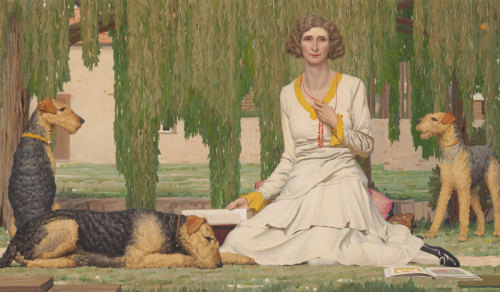Sidney Nolan's Daisy Bates at Ooldes (1950) is a remarkable study of an eccentric character who created her own mythologies. Daisy Bates was most recognised for her work as a journalist and welfare worker with Aboriginal communities. This is an imagined portrait of her in beekeeping gear, in the centre of an expansive and seemingly hostile landscape, with its red earth, hillocks and dead trees. What was Sidney Nolan thinking? Who knows? It's often difficult to tell.
For example, this monochrome version of Ned Kelly (1946) has blurred eyes as if they are shifting too fast to capture. Nolan's more famous Kelly series features the bushranger with a tin hat with the eyes the only things visible, so this is the inverse or the negative. There is no landscape or back story in this posthumous portrait, although the surrounding circle may suggest a noose. The image resembles a photo of Ned Kelly when he was aged 18.
The Head of a Soldier (1942) is a Dali-esque portrait by Sidney Nolan of a man with bloodshot eyes in an Australian army uniform. The model was Captain Bilby, Nolan's commanding officer. Nolan tried to avoid the army but ended up serving between 1942 and 1944. He depicted the soldier stripped of any form of identification, and the portrait lays bare Nolan's strong personal reaction to Australia's involvement in the war.
Man's Head by Albert Tucker is a portrait of a man in a collar-less shirt, with a crooked, craggy face, wiry hair and fleshy lips. Tucker used his art to convey his anger and distress at the darker aspects of humanity, either through social-psychological landscapes, or portraits such as this one based on newspaper photographs of criminals. This man was charged with kicking a small dog to death.
His portrait of Sydney Fox (1946) is an eerie, psychologically disturbing image. The lop-sided lazy eye, the smooth sallow skin, and the blue and yellow hues suggest bile, anger and depression.
Sydney Fox was an English serial killer who murdered his mother in 1929 in an attempt to obtain money from her life insurance policy. At the age of 31 in 1930 he was the last man hanged in Maidstone Prison, Kent. This portrait is based on Fox's police photo.
 Jude Rae's Interiors (1956) is a series of portraits of fellow Canberra artists with their eyes closed to negate the aphoriosm that eyes are the windows to the soul. The subjects, by closing their eyes, render themselves vulnerable, but they are also complete in their interior world. This art-work is quiet, reflective and poetically intense.
Jude Rae's Interiors (1956) is a series of portraits of fellow Canberra artists with their eyes closed to negate the aphoriosm that eyes are the windows to the soul. The subjects, by closing their eyes, render themselves vulnerable, but they are also complete in their interior world. This art-work is quiet, reflective and poetically intense.
The Girls at School (1959) by John Brack is odd. Three girls in their gingham dresses and school cardigans stand against a brick wall, one holding a bunch of daisies. Their neat hair, pulled off their face and tied back in pig-tails emphasises their flat faces and slightly down-turned mouths.
Brack was a skilled draughtsman and master of composition. He depicted his daughters in a bold, stylised way, by limiting the colour palette as if in a sepia photograph, and by flattening the frame.
It's quite a disturbing finish to the exhibition, and suggests that these Australians aren't all of such a cheerful, sunny disposition as many of us have been led to believe!








































